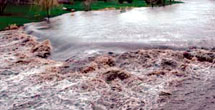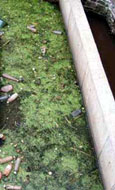Wet-Weather Flow
 Wet-Weather Flow is any storm generated flow e.g. rain, snowmelt.
Wet-Weather Flow is any storm generated flow e.g. rain, snowmelt.
There are three types of urban Wet-Weather Flow discharges:
- Stormwater
- Combined Sewer Overflow (CSO) (PDF, 118 KB, 9pp, about PDF)
- Sanitary-Sewer Overflow (SSO)
All are untreated discharges that occur during storm-flow events. Wet-Weather Flows have proven to generate a substantial amount of chemical, physical, and biological stress to receiving waters. Control of Wet-Weather Flow pollution is one of the top cleanup priority areas for the Agency. Problem constituents in Wet-Weather Flow include visible matter, pathogenic microorganisms, oxygen-demanding materials, solids, nutrients, and pollutants toxic to receiving water biota.
CSOs represent one of the major Wet-Weather Flow pollution sources. Historically, however, the control of CSO has proven to be extremely complex and costly. This complexity stems partly from past difficulties in quantifying CSO impacts on receiving-water quality and the site-specific variability in CSO volume, frequency, and characteristics. In addition, control costs for communities with CSOs are high.
Pollutants in Wet-Weather Flow discharges from many sources remain largely uncontrolled.
Characteristics of Wet-Weather Flow
A tabulation of pollutant concentrations in stormwater and CSO, is compared with concentrations from other treated and untreated wastewater (US EPA 2001). There is no apt description of "typical" combined wastewater or stormwater runoff characteristics because they are determined by local conditions, such as land use and the variable nature of rainfall runoff patterns. Each CSO situation must be evaluated independently and with respect to the particular receiving water(s) in question. Such evaluations should be related to both acute and chronic concerns.
| Contaminant Source | BOD5 (mg/L) | TSS (mg/L) | Total N (mg/L) | Total P (mg/L) | Lead (mg/L) | Zinc (mg/L) | Copper (mg/L) | FC (ct/100mL) |
|---|---|---|---|---|---|---|---|---|
| Untreated Domestic Wastewater | 100-400 | 100-350 | 20-85 | 4-15 | 0.10 | 0.28 | 0.22 | 107-109 |
| Treated Wastewater- Secondary | <5-30 | <5-30 | 15-25 | <1-5 | 0.15 | 0.08 | 0.03 | <200 |
| Urban SW Runoff | 10-250 | 67-101 | 0.4-1.0 | 0.7-1.7 | 0.18 | 0.02 | 0.05 | 103 - 107 |
| CSO | 25-100 | 150-400 | 3-24 | 1-10 | 0.37 | 0.17 | 0.03 | 105-107 |
Legend: BOD5 - Five-day
Biochemical Oxygen Demand; TSS - Total Suspended Solids; FC
- Fecal Coliform; Ct - Count |
||||||||
How can Wet-Weather Flow pollution affect me?
 Many beach closing are caused by Wet-Weather Flows due
to high pathogen indicator organism counts of fecal or total coliform
and e.coli and enterococci. Research is also determining
the effects of Wet-Weather Flow as a source of cryptosporidium and giardia.
Many beach closing are caused by Wet-Weather Flows due
to high pathogen indicator organism counts of fecal or total coliform
and e.coli and enterococci. Research is also determining
the effects of Wet-Weather Flow as a source of cryptosporidium and giardia.
Floatables, like plastic bottles, end up in a storm drain and can be discharged to a receiving water, decreasing aesthetic values or potentially harming wildlife.
Solids from storm drainage can affect dissolved oxygen in receiving waters, affecting biota, e.g., fish and macroinvertebrates.
Wet-Weather Flow typically carries nutrients which can cause algal blooms in receiving waters.
What causes Wet-Weather Flow discharge?
- Combined Sewer and Stormwater systems were designed to discharge to nearby receiving waters.
- The impacts of these discharges were not immediately known at the time of installation, but through research are now apparent.
What can limit Wet-Weather Flow pollution?
- Repairing aging infrastructure for Sanitary-Sewer Overflow.
- Treating Combined Sewer Overflow and Stormwater prior to discharge.
- Incorporating hydrology into onsite design to reduce or eliminate offsite discharge. This Best Management Practice (BMP) is often termed Low Impact Development (LID).
- Swales: controlled testing conditions at the UWRF.
![[logo] US EPA](https://webarchive.library.unt.edu/eot2008/20090508224408im_/http://www.epa.gov/epafiles/images/logo_epaseal.gif)